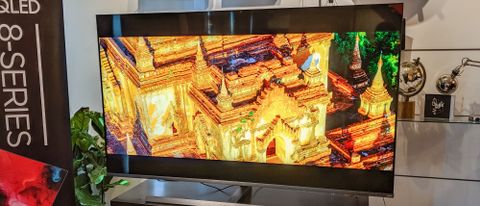Tom's Guide Verdict
The TCL 8-Series Roku TV brings premium design and QLED picture quality to TCL's first high-end TV, along with Dolby Atmos and a groundbreaking mini-LED backlight.
Pros
- +
Awesome picture quality
- +
Mini-LED backlight delivers rich blacks and bright highlights
- +
HDR10 and Dolby Vision supported
- +
Dolby Atmos right from the TV
Cons
- -
Mini-LED backlight still has haloing, just smaller
- -
Off-angle viewing throws colors off
Why you can trust Tom's Guide
This is the TCL 8-Series QLED TV. It has Roku smart functionality. It has quantum dots. It supports both Dolby Vision for HDR content and Dolby Atmos for immersive sound. It has a slew of premium features, including some innovations that only TCL can offer, and our review unit measures a whopping 75 inches from corner to corner.
TCL is a company known for its excellent-quality TVs, but in the North American market that reputation extends primarily to affordable, budget-friendly sets, such as the TCL 6-Series Roku TV and other inexpensive Roku TVs that frequently are found on our best cheap 4K TV list.
With the 8-Series, TCL hopes to gain a footing in the more premium TV space, offering a 4K smart TV that competes with bigger names like LG and Samsung. A look at the spec list shows that the 8-Series seems to have all the right features.
The 8-Series isn't simply TCL's best TV yet: It introduces two new technologies for TCL. The first is quantum-dot enhancement, or QLED, which (similar to Samsung QLED sets) uses a layer of light-emitting nanocrystals to boost the color and brightness offered on the display. The other is new to the TV market, with a backlight made up of thousands of mini LEDs, allowing tightly controlled backlighting that can be limited to small clusters of pixels instead of large swaths of screen.
Read on for our full TCL 8-Series QLED Roku TV review.
TCL 8-Series: Price and availability
The TCL 8-Series is available in two sizes, with a 65-inch model that sells for $1,999 and the 75-inch model featured in our review, which sells for $2,999.
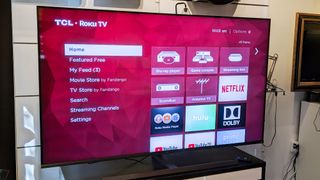
- 65 inches: 65Q825 ($1,999 at Best Buy)
- 75 inches: 75Q825 ($2,999 at Best Buy)
While the two sizes will differ in a few areas, the majority of features are identical between the two. And where they do differ – namely in the size of the screen, the overall dimensions of the set and the number of mini-LED dimming zones behind the LCD panel – the overall performance should still be the same.
The 8-Series is offered only in the United States through TCL USA, but Europe will have a similar mini-LED-equipped TV in the TCL X10 QLED. Like the 8-Series, the X10 pairs a quantum-dot-enhanced LCD panel with a mini-LED direct backlight for improved brightness and reduced light blooming.
TCL 8-Series (75Q825) specs
| Price | $2,999 |
| Screen Size | 75 inches |
| Resolution | 3840 x 2160 |
| HDR | HDR10, Dolby Vision, HLG |
| Refresh Rate | 120 Hz |
| Ports | 4 HDMI, 1 USB |
| Audio | 15 W + 15 W with Dolby Atmos |
| Smart TV Software | Roku TV |
| Size | 66.0 x 37.9 x 3.1 inches [w/o stand] |
| Weight | 100.3 pounds [w/o stand] |
TCL 8-Series: Design
As you would expect with any 75-inch TV, the 8-Series we reviewed is big. Even without the stand, the larger 8-Series model measures 66.0 x 37.9 x 3.1 inches and weighs just a hair over 100 pounds (100.3 pounds, for anyone watching the scale).

The 8-Series has a fairly elegant design, with narrow bezels around the display and a stripe of brushed aluminum along the bottom of the screen, finished with a gunmetal-gray color that looks quite sophisticated.
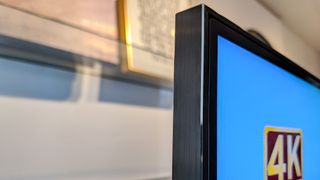
The accompanying stand has a T-shaped footprint and an L-shaped, angled stand that attaches in the back, in a matching gunmetal finish.
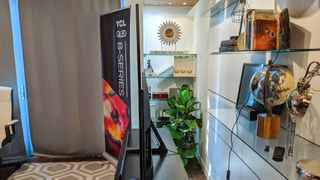
The back of the set looks surprisingly chic, with the top half of the display backed with a black mirrored finish and the bottom half housing the speakers and internal components. That bottom half of the chassis skips the usual plain black plastic look and instead is covered in vertical ridges that then blend seamlessly into the ventilation and speaker grills. Also on the back of the set are holes for a VESA wall mount, which will accommodate a standard 300 x 300-millimeter mount.
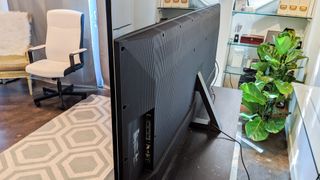
For controlling the set without the remote, there is a large power button on the back. It may look like a large, simple button, but it's actually a clickable four-direction joystick of sorts, which also offers directional controls for navigating through apps and menus.

TCL 8-Series: Ports
Port selection on the 8-Series includes four HDMI ports, including one with ARC support, a single USB port, a cable connector for the TV's built-in tuner and Ethernet for wired network connectivity.
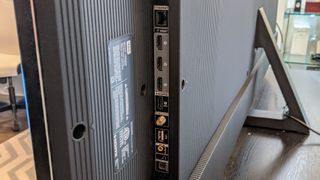
It also has built-in 802.11ac Wi-Fi for connecting to your Wi-Fi router. A headphone jack provides audio-out as well as an optical SPDIF connector for older surround-sound systems that don't use HDMI.
TCL 8-Series review: Performance
There are plenty of elements that play into making a TV better than average, like smart features or excellent sound quality. The 8 -Series has all of these bases covered, but none of it matters without a great picture. And this is where the 8-Series really earns its premium designation, combining technologies like quantum-dot enhancement and mini-LED backlighting with a high-quality LCD that delivers great color and video processing that makes the most out of whatever content is being shown.
TCL already made solid TVs, but the 8-Series steps up the quality while maintaining everything the brand was already doing right.
For an LCD set, the 8-Series matches the best models on the market, reproducing 99.9% of the sRGB color space. That's on the same level as the Vizio M-Series Quantum (another non-Samsung set with quantum-dot enhancement), which was also within a hair's breadth of 100% gamut. And it's actually a touch ahead of premium competitors, like the Samsung Q90 QLED and the Sony X950G 75 inch (both scored 99.8%). The only set to offer a wider color gamut was the LG C9 OLED, at 132.1% – exceeding the Rec 709 color space by a large margin.
Watching Planet Earth 2, the 8-Series' excellent color quality lent a vibrant realism to a cinematic jungle excursion. The verdant green of a leafy jungle looked spectacular, and a bright sky marked with white clouds looked realistic in its perfect blues and varied grays. The several animals shown offered a rainbow of colors and hues. The TCL 8-Series handled the creatures' colors beautifully, whether it was the brown-and-black fur of a monkey, the yellow-and-green beaded skin of a lizard or the bright reds, blues, oranges and other colors of hummingbirds feeding at flowers.
MORE: QLED vs. OLED TVs: Who Wins?
Color on the TCL 8-Series is also highly accurate, with the set scoring a Delta-E average of 1.5 (closer to 0 is better). That score indicates the display's deviation from perfect color reproduction and smaller scores indicate a higher level of accuracy. That's one of the best scores we've seen all year, matching the Samsung Q90 QLED (1.5) and even offering slightly better accuracy than the LG C9 OLED (1.8). And compared with slightly less premium sets, like the Sony X950G Android TV (2.5) and the Vizio M-Series Quantum (3.62), the differences will be more noticeable.
There is more to a display's quality than just color, though, and the 8-Series did well in most of these areas. Fast action was extremely smooth, with no discernible flicker or judder as people and objects moved quickly. Watching the boxing in Creed II, the flying fists and sprays of sweat and blood looked natural and ferociously fast. Most notably, there was none of the smearing or digital noise that often can be seen on lesser displays.
For an LCD set, the 8-Series matches the best models on the market, reproducing 99.9% of the sRGB color space.
Viewing angles are quite wide, allowing me to view the TCL 8-Series’ screen from almost any position without losing viewability. That's not to say that there was no observable change in color quality – some color shifting crept in on the 8-Series when viewed as little as 10 degrees off center – but it doesn't wash out terribly, and the picture can still be enjoyed by several people at once.
However, black levels did not fare as well in off-angle viewing. Looking at the TV head-on offered very rich black levels, but stepping away from that sweet spot and viewing at an angle introduced the same sort of elevated grays we see on other LCD sets. It's not a major issue, but it does expose a weakness of present mini-LED technology.
Comparing the 8-Series side by side with the LG C9 OLED and the Samsung Q80 QLED TV, the TCL 8-Series stands on its own. Overall picture quality may differ slightly between these competing models – the LG C9 seemed to have slightly richer color, but didn't offer the same brightness, and the Samsung Q80 QLED lacked the tightly controlled backlight afforded by TCL's mini-LED technology. What was truly unexpected was just how well the 8-Series handled near-black colors and dark shadows; the set managed to maintain detail even in dark environments and high-contrast situations.
TCL 8-Series: Mini LED, backlighting and HDR performance
The truly impressive aspects of the 8-Series revolved around the mini-LED backlight, which delivered impressive high-dynamic-range (HDR) performance and brightness.
In our favorite test of local dimming, a scene from Blade Runner 2049 that shows sparks rising up from a campfire, anything short of an OLED will demonstrate some halos, as the set tries to illuminate individual glowing sparks. When contrasted against the night sky, those halos stand out for their gray glow, contrasted against the black background. It's a great test to see what local dimming can do when pushed to the limit, and in this case, it showed us how tightly controlled the 8-Series' mini-LED backlight really is.
Those small halos followed each glowing ember with a small cloud of elevated gray, as the mini LED backlight tracked closely with every individual spark up through the black sky. The LG C9 OLED, on the other hand, had no such haloing, demonstrating what ideal backlighting looks like. But unlike every other LCD set we've reviewed – including Samsung's premium QLED sets – the halos shown on the 8-Series were very small. Even the best TVs will light up larger portions of the screen, simply because each dimmable zone is an inch or more across. Not so on the 8-Series, which illuminated much smaller portions of the screen.
And that's the big advantage offered by mini-LED technology. Where other TVs with local dimming can subdivide the screen into dozens or even a few hundred dimmable zones, the TCL 8-Series has 25,000 mini LEDs, each one addressable as a single lighting zone. That's a huge advantage over something like the Vizio M-Series Quantum, which has 90 dimming zones, or even the Samsung Q90 QLED 65-inch model, which has 435. In fact, mini LED offers the most zones this side of OLED, which numbers in the millions, thanks to OLED's ability to light up each pixel individually.
MORE: Check out our run-down of the best TVs right now
But, even though the mini-LED backlight is an impressive innovation and a huge step forward in LCD technology, it's not flawless. Black levels look superb when viewed straight on, but I saw minor inconsistencies, such as slightly boosted brightness in the corners of the display (possibly in an attempt to counter the corner shadows so often seen on LCD sets), and letterbox movies will often have some backlighting spillover into the black bars on top and bottom.
I noticed another issue at the edges of the display, where you can see slight irregularities in the lighting. The brightness of the backlight is solid and consistent across the majority of the screen, but along the edges, where the screen meets the bezel, small shadows can be spotted. These irregularities are very small, and only noticeable when you look for them – I noticed them most when viewing single-color test screens used specifically to spot such inconsistencies. It shouldn't be noticeable when viewing normal content, but the fact remains that they are there, and I saw them along all four edges of the display.
Consistency issues aside, HDR performance looks superb on the 8-Series. Watching the lead up to the big boxing match in Creed II, each boxer has his entrance into the arena, each providing a nice HDR demo of bright highlights and low-light performance. As Viktor Drago walked into the arena, the fireworks and flames that announced his arrival looked bright and hot. But as the lights dimmed for Adonis Creed's entrance, suddenly there were significant clouds of elevated gray, which mottled the screen as it struggled to handle the low lights of a nearly pitch-black arena and laser light show.
However, I observed these backlighting issues only in normal backlighting mode. When I enabled enhanced contrast, the issue seems to disappear. And when compared with the Samsung Q80, which has excellent backlight performance, the 8-Series actually offered better black levels and better backlight control. When compared against the LG C9, however, the difference is a bit more stark, showing that LCD technology still has a long way to go before it can truly match OLED.
All told, the mini-LED backlighting is quite impressive and a strong innovation from TCL, but it does have to compete against Samsung's highly refined FALD technology, which includes special layers in the LCD stack to improve upon these area issues, and it all falls a bit short when compared with the perfect blacks offered by OLED.
TCL 8-Series: Gaming performance
When we fired up our Xbox One X, we were thrilled to see that the 8-Series has Auto Game Mode, which switches to low-latency game mode as soon as the console is connected and powered on. You don't have to go through the menus to find picture settings. Heck, you don't even have to pick up the remote.
The 75-inch TCL is faster than the Sony X950G 75-inch Android TV (22.4 milliseconds), offering better responsiveness for gaming on a truly big screen.
The 8-Series also offers full-featured gaming support. Gaming at 4K resolution and 60-Hz refresh rates is support, along with HDR10 in games. That matches the best 4K gaming TVs we've seen. Streaming media also gets full support, with 10-bit color and multiple frame rates supported (24 Hz, 50 Hz and 60 Hz) as well as both HDR10 and Dolby Vision for movies and streaming media.
And it's not just format support that makes the 8-Series a great TV for gaming. When we tested the lag time of the TV, using our Leo Bodnar input lag tester, we measured the lag time at 20.2 milliseconds. That's faster than the LG C9 OLED (21.2), the Samsung Q90 QLED (24 ms) and the Vizio M-Series Quantum (29.9 ms). Most notably, the 75-inch TCL is faster than the Sony X950G 75-inch Android TV (22.4 ms), offering better responsiveness for gaming on a truly big screen.
TCL 8-Series review: Audio
As much as TCL has delivered on its promised premium display quality, the sound may be even better. Listening to the iconic Rocky theme played during portions of Creed II, the dual 15-watt speakers in the 8-Series produced rich, clear tones as the triumphant horns of the Rocky theme blared. Even at high volume, the sound quality managed to be distinct and clear without the reediness or clipping heard in many competitors' models.
Even when I dialed up the volume to maximum levels – which you'll probably never do in your own home, because even at 50% volume, the 8-Series produces powerful sound – to 90% and higher, the 8-Series handled every sound exceptionally well, with clarity in both loud and more subtle circumstances. Tense, whispered conversations in Blade Runner 2049 were extremely clear, and louder sounds such as a gunshot or someone being pounded through a wall had the requisite percussive strength.
What's perhaps more impressive is that the 8-Series boasts Dolby Atmos sound. And that's not simply support for Atmos in decoding, which you would need with an Atmos-capable soundbar – that's Atmos delivered by the speakers in the TV. That's a true premium feature that we've rarely heard offered by any other 4K set.
If you've never heard it, Atmos is a markedly better sound experience than even 5.1 sound; it offers immersive sound not only to the right and left of the listener, it also extends above. And thanks to Atmos' object-oriented sound, it can even produce spatial illusions, with sounds like helicopters overhead, cars whizzing by and more.
TCL 8-Series review: Smart features
Like all of TCL's smart TVs, the 8-Series is built with the Roku smart TV OS, a longtime favorite of ours. And because TCL partners directly with Roku in developing its smart TVs, the brand consistently offers the best Roku experience on the market. This is equally true on the 8-Series, which uses the latest version of Roku's excellent smart TV interface.
We like pretty much everything about Roku, from the thousands of apps (Roku calls them "channels") to the simple, tiled interface. Navigation is intuitive, and the app selection includes all of the major players, like Netflix, Hulu, Amazon Prime, HBO Now and pretty much anything else you can think of.

It also has a full-featured mobile app, which lets you use your phone as a remote control, browse content, cast media from your phone to the TV and even search for new apps on your phone. But my favorite feature has long been private listening, which lets you route the TV sound through the app, so that you can listen with headphones, keeping things quiet for others in the house.
I was also pleasantly surprised to see that the 8-Series remote had a built-in microphone for voice interaction. Using spoken phrases for content search and function control has long been a differentiator for premium sets, and most Roku TVs don't have it built into the hardware (though it is available through the Roku app). It's a nice touch, and one that makes the 8-Series experience feel a little richer.
TCL 8-Series review: Remote control
Last stop in our TCL 8-Series QLED Roku TV review is the remote. As with the TV smart features, TCL embodies the best capabilities of Roku TVs, and this is also the case with the remote.
The Roku TV remote looks extremely familiar, following the template of past remote designs. The large purple directional buttons have a comfortable rubbery texture instead of the glossy plastic used on older models. The directional pad is still permanently placed, along with controls for media playback, settings and menu navigation, home button and a selection of channels.


This particular model also includes a microphone for voice control. As such, it comes with a small microphone button nestled in between the settings and return buttons.
The remote also has some dedicated app buttons, and the channels offered on the remote include favorites like Netflix, Hulu, ESPN Plus and the Roku channel. The inclusion of the Roku channel is a nice addition, since Roku only added its own free streaming service recently. While non-U.S. markets may have a different lineup of app buttons, the four apps mentioned should be standard for the 8-Series (and likely other new TCL sets) across the U.S.
The remote design has been updated, with a slightly more squared-off shape and a more defined profile that can be felt when held in the hand. There's an indentation on the back of the remote that provides a comfortable place for the index finger to rest and also serves as a nonvisual indicator of which way the small remote is pointing. It's a subtle touch that makes it easier to grab the remote in the dark and use it, even when you can't see which button is which.
TCL 8-Series review: Bottom line
As TCL's first foray into the premium TV market, the TCL 8-Series QLED Roku TV is impressive. The one-two punch of great picture and excellent sound are matched by a great design and refined feature set. Dolby Atmos delivers fantastic sound, without an extra soundbar, and the QLED display delivers some of the best color and brightness we've seen all year. The fact that TCL has also managed to deliver a new technology in this first premium model is a body blow to top-tier competitors, letting the big names like Samsung, LG and Sony know that TCL is here to win.
While this first-generation model has a few wrinkles to iron out, like the less impressive off-angle viewing, there's no doubt that the TCL 8-Series should be on the short list of models to consider when you're shopping for a top-of-the-line TV. Sure, the LG C9 OLED remains our top pick, thanks to OLED's pixel-perfect illumination, but on every other front, the TCL 8-Series is giving it a run for its money. And while sets like the Samsung Q90 QLED have a slightly more polished quantum-dot display, it's already a tight race, and I'm excited to see how TCL closes the gap with the next iteration.
But all things considered, if you're already a fan of Roku or are upgrading from a less-expensive set and have some brand loyalty toward TCL, there's no reason not to get the 8-Series. In fact, I expect that in the coming months, we'll see a lot of attention focused on the TCL 8-Series. It's easily the best model TCL has put out and a strong first step out of the midrange and budget-friendly categories the company is best known for.
Brian Westover is currently Lead Analyst, PCs and Hardware at PCMag. Until recently, however, he was Senior Editor at Tom's Guide, where he led the site's TV coverage for several years, reviewing scores of sets and writing about everything from 8K to HDR to HDMI 2.1. He also put his computing knowledge to good use by reviewing many PCs and Mac devices, and also led our router and home networking coverage. Prior to joining Tom's Guide, he wrote for TopTenReviews and PCMag.
-
aaronwt You really need to change this review.Reply
In it was said "..the TCL 8-Series has 25,000 mini LEDs, each one addressable as a single lighting zone"
It most certainly does not address the Mini LEDs individually. The 75" TV has around 900 zones. With each zone being made up of multiple Mini LEDs. The TV does not even have the processing capability to address 25K zones.
